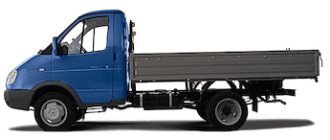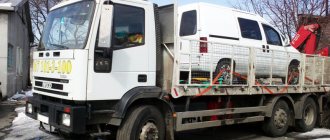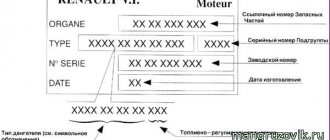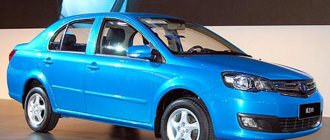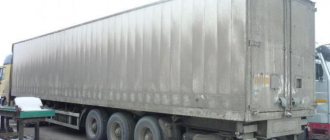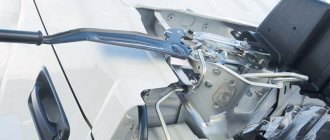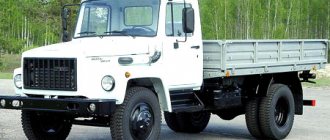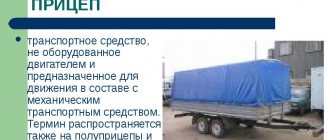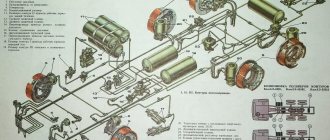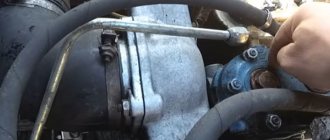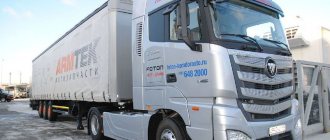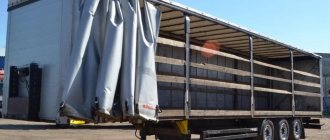Trailer purpose
A trailer can be most fully described as a non-self-propelled vehicle that allows the transportation of various or strictly defined loads due to the power of the tractor, with which it is connected by a special coupling device. Such a combined vehicle is called a road train. It is important to note that the tractor is able to work with several trailers at once.
A special feature of operating a truck together with a trailer is the more complex control of such a vehicle. Therefore, in order to work on a road train, a driver needs to undergo additional training and obtain a permit (the corresponding category in the certificate).
Trailer GKB-8350 for KAMAZ
Such a trailer belongs to the category of non-self-propelled transport, used as an additional means of increasing the possible volume of transported cargo. To connect it to the tractor, special coupling units are used. This allows you to create a road train, which can simultaneously consist of several similar trailers. But when using them, more difficult traffic conditions must be taken into account, because the length of such a road train is longer than that of a conventional truck, but the power remains the same. Because of this, in order to use a trailer, the driver must undergo additional training, as a result of which he will open the appropriate category on his driver’s license.
Due to the increase in the total weight of freight transport, the braking distance, which is an important safety parameter, also increases.
Trailers are divided into two separate categories based on the purpose of the vehicle:
The former include onboard, awning, and others used for transporting different types of cargo, while the latter are used only for one type of cargo transportation. GKB 8350 is a two-axle flatbed trailer that allows transportation of up to 8 tons. The model belongs to the general purpose category. The main tractor with which this towbar is used is KAMAZ 5320. The positive qualities of the unit are:
- The ability to create a transport and loading complex, for example, when installing a manipulator on a tractor. In this case, it is possible to immediately load a certain cargo onto a cargo trailer without the use of third-party devices.
- Reducing the load on each axle of the road train. As a result, this allows the use of such vehicles on roads where weight restrictions are established.
- Reducing fuel and time costs for transporting cargo by approximately 40%.
- Possibility of increasing the amount of transported cargo, sometimes several times.
But there are also disadvantages to using a trailer. Thus, the speed of a truck as part of a road train is reduced by approximately 30%. This is due to the increase in weight while maintaining engine power. The trailed unit requires regular maintenance to keep it in good condition, which increases operating costs. The maintenance frequency of the GKB-8350 is similar to that of the KAMAZ-5320 truck.
Advantages of using a trailer
The main advantages when using a trailer should be considered:
- increase in the amount of transported cargo, sometimes almost 2 times;
- reducing the weight per axle of a road train with an equal load with a conventional truck, which allows driving on roads with weight restrictions;
- the possibility of creating a specialized vehicle, for example, a tractor equipped with a manipulator will be able to load and transport products not only on its own platform, but also on a trailer;
- reduction of material costs for transportation, including fuel, by up to 40%.
The main disadvantage of using a trailer is considered to be a reduction in the speed of a road train compared to a truck by an average of 30%.
Retrofitting a tractor (in the absence of serial standard devices) for working with a trailer should be considered a certain inconvenience. Such material costs are one-time in nature and quickly pay for themselves with the constant operation of the road train.
Trailer classification
Trailers for practical use are divided into two large categories: general purpose and specialized. General transport includes flatbed, tilt and others, which allow the transportation of cargo of various types. Specialized ones include panel carriers, vans, cement tankers, pipe carriers, tanks, disbanding trucks, car carriers, etc.
An important characteristic of a trailer is its load capacity. According to the international classification system, cargo trailers are divided into the following categories:
In addition, the division by the number of axes is distinguished.
The GKB 8350 trailer is a two-axle flatbed vehicle with a metal platform, with a load capacity of up to 8.0 tons, designed for transporting goods for various purposes. The main tractor for the GKB 8350 trailer is KamAZ 5320.
The factory name means that the trailer was developed by the Head Design Bureau for trailers, model No. 8350. A photo of the GKB 8350 trailer is presented below.
Technical characteristics of the trailer GKB 8551
In order to significantly increase the volume of cargo that a vehicle can transport, motorists everywhere use a variety of trailer models. The GKB 8551 dump trailer seems to be an effective and reliable device for transporting various types of cargo, even on roads that are in poor condition.
- Load capacity
- Dimensions
- Features of operation
- Conclusion
Load capacity
Before studying the technical characteristics of the GKB 8551 trailer, as well as its other features, you need to familiarize yourself with its manufacturer in more detail. The model is produced by the Krasnoyarsk Trailer Equipment Plant, which specializes in the manufacture of products in this category.
Despite the fact that the GKB 8551 dump trailer was developed quite a long time ago, its production continues to this day.
This allows you to purchase the product both in new and used condition.
The product belongs to the category of biaxial devices and is characterized by excellent maneuverability, which allows it to easily overcome even impressive defects in the road surface.
GKB 8350 device
Among the main units of the GKB 8350 trailer, it is necessary to highlight:
- frame;
- rotating trolley;
- front and rear axles;
- drawbar;
- front and rear suspension;
- brake mechanism;
- wheels.
The metal platform has side boards, consisting of three sections, interconnected by special racks, and a rear board. All sides (except the front) can be opened for ease of loading or unloading. The metal floor of the platform is covered with special wooden panels, which can be dismantled if necessary. To improve the conditions of use, the GKB 8350 trailer can be retrofitted with an awning together with a collapsible frame.
Posts 1 page 3 of 3
Share119-05-2015 13:12:01
- Author: nik-45
- Administrator
- Registered: 09/15/2014
- Posts: 2681
- Age: 59 [1961-03-10]
- Time spent on the forum: 25 days 21 hours
- Last seen: Yesterday 10:39:19
MAZ-5207V
Two-axle car trailer with a platform.
DESIGNATIONS Factory - MAZ-5207V (Minsk Automobile Plant model 5207 modification B) Type - 2-PN-6 (2-axle Low-bed Trailer with a lifting capacity of 6 tons)
PURPOSE The MAZ-5207V trailer is designed for transporting goods as part of a road train on all types of roads.
DEVELOPMENT, PRODUCTION The MAZ-5207V trailer-chassis was developed at the Minsk Automobile Plant and was produced since 1955. Serial production of the MAZ-5207V trailer was discontinued in 1974.
TECHNICAL DESCRIPTION The trailer frame is welded and consists of two side members connected to each other by cross members. A towing hook is installed at the rear of the frame. The suspension is spring, consists of four longitudinal semi-elliptical springs, two installed on each axle. The front axle consists of an I-beam, curved in the middle, with steered wheels. The wheels are turned through a system of rods and levers depending on the rotation of the drawbar. The turning device ensures that the trailer wheels rotate from the middle position: internal - at an angle of 19 degrees. 10 minutes, external - at an angle of 16 degrees. 15 min. The rear axle is a tubular beam. Wheels - 12.00-20 The service braking system applies to all wheels of the trailer. The brake system drive is pneumatic, made according to a single-wire circuit. The parking brake system acts on the wheels of the rear axle of the trailer. The brake system drive is mechanical, located on the right side. Wooden platform. The towing device consists of a drawbar, pivotally connected to the carrier, similar to the towing device of the SMZ-810 trailer.
MODIFICATIONS
— MAZ-5207VSh — trailer-chassis with a carrying capacity of 6750 kg without an onboard platform for installing various equipment and bodies. A KUNG-P6 van body has been developed for the trailer.
— MAZ-847 — dump trailer with a carrying capacity of 6000 kg.
TECHNICAL CHARACTERISTICS Load capacity, kg: 6000 Dead weight (equipped weight), kg: 3200 (3400 according to old primary sources) Overall dimensions with drawbar, mm: - length: 6580 (6380 according to old primary sources) - width: 2500 - height: 1520 (1480 according to old primary sources) Overall dimensions without drawbar, mm: - length: 4690 - width: 2500 - height: 1520 (1480 according to old primary sources) Wheelbase, mm: 3000 Track, mm: - front wheels: 1950 - rear wheels: 1950 Ground clearance, mm: 290 Internal dimensions of the platform, mm: - length: 4550 - width: 2350 - height: 480 Loading height, mm: 1040 Tire size: 12.00-20 Maximum towing speed with full load, km/h: - on the highway : 50 — on dirt roads: 25
SOURCES OF INFORMATION - Transport trailers and semi-trailers. - M.: Military Publishing House, 1981.-191 p., ill., UDC 629.114.3 - A short reference book on domestic cars and trailers. Chaban D.V. - M.: Voenizdat, 1971
Share219-05-2015 13:31:30
- Author: nik-45
- Administrator
- Registered: 09/15/2014
- Posts: 2681
- Age: 59 [1961-03-10]
- Time spent on the forum: 25 days 21 hours
- Last seen: Yesterday 10:39:19
MAZ-8926 (type 2-PN-6M) Low-bed two-axle automobile trailer with a loading platform.
designation - MAZ-8926 (Minsk Automobile Plant model 8926) Type - 2-PN-6M (2-axle Low-bed Trailer with a load capacity of 6 tons, Modernized)
PURPOSE The MAZ-8926 trailer is designed for transporting goods as part of a road train on all roads and terrain.
DEVELOPMENT, PRODUCTION The MAZ-8926 trailer was created at the Minsk Automobile Plant in 1974. Made on the basis of the MAZ-500 car
TECHNICAL DESCRIPTION The trailer frame is welded, consists of two side members and external beams connected to each other by cross members, and is the base of the platform floor. In the rear part of the frame, a subframe with brackets for the rear springs is welded from below and a traction hook is installed (the traction hook, pneumatic and electrical outlets are installed upon additional request). A rotating trolley consists of a frame, a rotating device, a drawbar, an axle with wheels and springs. The trolley frame is welded and consists of side members connected by cross members. The drawbar brackets are attached to the front cross member. The turning device consists of a single-row ball turntable, the upper part of which is attached to the trailer frame, and the lower part is attached to the turning trolley frame. The trailer drawbar is welded, has a removable loop made in accordance with GOST 2349-75, and a special mechanical type suspension with a manual drive that regulates the height of the drawbar position when coupling with the tractor and supports the drawbar in a horizontal position when the trailer is uncoupled. In the transport position, the drawbar suspension must be disconnected. To move the road train in reverse, the swivel bogie is blocked relative to the trailer. The blocking is carried out manually using a special locking device, which must be turned off after maneuvering. The suspension is spring, consists of four longitudinal semi-elliptical springs, two installed on each axle of the trailer. The front and rear axles are tubular beams. The wheels are discless, rim designation 216V-508 (8.5V-20). Pneumatic tires 320-508 (12.00-20) models IYAV-12A and IYAV-12B. Air pressure in tires is 4.8 kgf/sq.cm. (with a total trailer weight of 12,000 kg, tire pressure is 5.6 kgf/sq.cm.). The service braking system applies to all wheels of the trailer. The brake system drive is pneumatic, made according to a combined scheme. The wheel brake mechanisms of the trailer are interchangeable with the wheel brake mechanisms of the MAZ-500A car. The parking brake system acts on the wheels of the rear axle. The brake system drive is mechanical, screw type, the drive handle is located on the left side of the trailer. The platform is metal, with a wooden floor. The rear and side sides are folding. Wooden extension sides. The sides and side posts are unified with the sides and side posts of MAZ vehicles. The trailer is equipped with removable arches and an awning. Electrical equipment is a single-wire 24 V DC system powered by the vehicle’s on-board network. The electrical system includes: 1 rear light FP130-V; 1 rear light FP130-G; 1 underbody light FP103-G; 1 plug PS300A-150; 1 plug socket PS300A-100; 2 connecting panels PS2-A2; 2 connecting panels PS1-A2; 4 connecting panels PS4-A2; 1 plug socket PS400; 1 switch VK700. It is allowed to install rear lights FP101-V, FP101-G and direction indicators UP5-B. There are mooring eyes on the frame side members designed to secure the trailer for air, sea and rail transportation with equipment mounted on it.
Trailer modification
Thanks to the technical characteristics of the GKB 8350 trailer, as well as its good design, versatility, reliability, ease of operation and low costs for technical work, its widespread distribution and use has been achieved. Therefore, to develop the next, more lifting model, it was taken as a basis. In addition, the significant unification achieved by both trailers simplified production, technical maintenance and possible repairs.
Read also: Chip tuning Ford Focus 3
In terms of technical characteristics, the main difference between the GKB 8352 and 8350 trailers was the increased load capacity from 8.0 to 10 tons. Such an increase, with the design practically preserved, was achieved by increasing the rigidity of both spring suspensions of the new trailer and making the rotating bogie from reinforced metal. As a result of the modernization, the total weight of the GKB 8352 increased to 13.7 tons.
A relative disadvantage of this improvement was the increase in loading height to 1.37 m (+ 5 mm).
Trailer model GKB-8352
Due to its versatility, reliability and high performance characteristics, the GKB-8350 trailer was widely used in its time. Considering its advantages, it was decided to use it as a basis for the development of new models. As a result, the designers created the GKB trailer 8352. The main difference was the maximum load capacity of the unit of 10 tons. This was made possible by maintaining the same design, but increasing the rigidity of the spring suspension, as well as the use of more durable materials. After modernization of the GKB-8352 model, the maximum transported weight increased to 13.7 tons.
In order to increase the volume of cargo transported by one vehicle, the GKB-8350, which belongs to the category of general purpose trailers, is used. Over time, new modernized versions of GKB-8352 units were released, having higher consumer properties.
Maintenance
Like any vehicle, for reliable and long-term operation, the trailer must undergo technical work (MOT) for proper maintenance. The main operations during maintenance are:
- Second regulation (TO-2). In addition to all the listed TO-1 operations, the alignment of the wheel axles, as well as the frame and drawbar, is diagnosed. If necessary, adjustment operations are performed. The condition of the metal platform is also checked.
The maintenance frequency of the trailer coincides with the base KamAZ 5320 tractor and is: TO-1 - 4 thousand km, TO-2 - 12 thousand km. This design solution reduces the downtime of the road train and increases the operational period.
Flatbed trailer GKB 8328-01
Flatbed trailer GKB 8328-01. Produced by the Lugansk (formerly Voroshilovgrad) automobile assembly plant since 1988. The body has a wooden floor with metal or wood-metal sides, the rear side sides are folding. Supplied in the same way: with extension sides; with main sides, frame and awning; trailer chassis with and without flooring.
Flatbed trailer GKB 8328-01. Produced by the Lugansk (formerly Voroshilovgrad) automobile assembly plant since 1988. The body has a wooden floor with metal or wood-metal sides, the rear side sides are folding. Supplied in the same way: with extension sides; with main sides, frame and awning; trailer chassis with and without flooring. Basic chassis – 2-PN-4 Main tractor – ZIL-431410 and ZIL 433100 Payload capacity, kg – 5500 Curb weight, kg: — 2700 — front axle — 1430 — rear axle — 1270 Gross weight, kg: — 8200 — on the front axle - 4100 - on the rear axle - 4100 Overall dimensions of the car with body, mm: - length - 7452 - width - 2500 - height - 1970 - height with awning - 3275 Internal dimensions of the body, mm: - length - 5244 - width - 2428 — side height — 608 Internal dimensions of the body with wood-metal sides, mm: — length — 5176 — width — 2352 — side height — 608 Loading height — 1275 Drawbar height, mm — 800 Base, mm — 3670 Track, mm — 1800 Ground clearance , mm – 400 Permissible speed, km/h – 80 Platform volume, m?: — with main sides — 7.74 — with main and extension sides — 12.86 — with main sides frame and awning — 22.44 Brakes — service brake - with drum mechanisms, separate drive to the front and rear axles. The pneumatic drive is made using a two-wire or combined scheme - parking brake - on the brakes of the rear axle, the drive is mechanical. Front and rear suspension - on longitudinal semi-elliptic springs, rear ends of the suspension with sliding supports. Swivel device - turntable on balls. Wheels - disc, rim 7.0- 20 Tires – 9.00R20(260R508) or 9.00-20(260-508) Number of wheels – 4+1 Air pressure in tires, kgf/cm 2: – 9.00R20(260R508) – 6.5 – 9, 00-20(260-508) — 6
- Type Airborne
- Load capacity, t 5.5
- Number of axles, pcs. 2
Features of operating a vehicle with a trailer
When working together with a vehicle and a trailer, it should be taken into account that the road train has an increased total weight, and therefore the braking distance increases. This is important to consider when choosing a safe distance and when stopping, and the effectiveness of the braking system is the most important component of the safe operation of a road train.
Among other features, it is important to highlight the decrease in dynamics. The road train picks up speed noticeably slower, which must be taken into account when overtaking or changing lanes. When driving in turns, it is necessary to avoid jerking when accelerating or braking, as such actions can cause the trailer and the entire road train to skid.
Reversing maneuvers on a vehicle with a trailer are more complex and require certain skills and qualifications. But in any case, if there is an opportunity for control and assistance in performing such actions, it is better to involve an assistant monitoring the situation behind the road train.
Rating GKB 8350
The general purpose trailer GKB 8350 was produced at the Stavropol trailer plant since 1974, and the modification GKB 8352 entered the production line in 1980. Thanks to the successful design, reliability and large number of copies produced, there is currently a significant number of trailers on the secondary market. You can purchase a copy from the mid-80s in good working condition for approximately 150 thousand rubles.
Considering that the design of the GKB 8350 trailer uses a considerable number of parts from the KamAZ vehicle, if necessary, it will not be difficult to repair such a trailer, and the efficiency of using the road train, together with the low costs of maintaining the trailer itself and its versatility, will quickly recoup the purchase costs.
Currently, the Stavropol plant has been transformed into and continues to produce a variety of semi-trailers and trailers with a carrying capacity from 6 to 13 tons. A further development of the GKB 8350 was the SZAP 8355 universal flatbed trailer, which in its parameters and technical characteristics is very similar to its predecessor.
The weight of KAMAZ ranges from 6180 to 27,130 kg. This indicator is influenced by the make of the car and its equipment. The automobile heavyweight received its name from the name of the plant where it was produced both in Soviet and Russian times, from 1976 to 2001. The first production batch rolled off the assembly line of the Kama Automobile Plant on February 16, 1976. Before this, since 1974, only prototypes under the KAMAZ-5320 brand were assembled at the plant. Based on it, the following were developed: the KamAZ-5410 truck tractor, the KamAZ-5511 dump truck, the KamAZ-53212 flatbed truck with an extended base, the KamAZ-53213 chassis, and a whole family of two-axle analogues: the KamAZ-5325 and the basic KamAZ-4325, the KamAZ-43255 dump truck , truck tractor KamAZ-4410. The first two models were born in 1977, the rest a little later. Each modification has its own characteristics, but in general the power units are similar to each other.
Read also: Electrical diagram of Ford Mondeo 4
The weight of KAMAZ ranges from 6180 to 27,130 kg.
A refrigerated cargo truck is a vehicle for transporting goods that require the creation of a special temperature regime to preserve product characteristics. Such cargo includes: food, perfumes, cut flowers, medicines. The components of a refrigerated truck are a thermally insulated body, a refrigeration (refrigeration and heating) unit, and a chassis. All structural elements must match each other and the required temperature range. The refrigeration unit creates certain climatic conditions and then maintains them at a given level. Thanks to the casing with multi-layer walls, a constant temperature is maintained for a long time when the unit is turned off.
Depending on the nature of the goods, the cargo compartment is equipped with:
— two-tier system for product placement;
— pallet boxes;
— guides on which hooks with meat carcasses are hung;
- flower carts.
Vehicles adapted for transporting carcasses - carcass trucks - have a reinforced frame and round or rail guides.
Refrigerated trucks are manufactured in two versions:
— on the chassis of a flatbed semi-trailer;
- on its own chassis with a load-bearing floor panel, this option is characterized by reduced weight combined with high load capacity.
Refrigerated vans are manufactured individually for a specific chassis type.
In the early 1980s, the USSR government decided to build a plant in Tiraspol (Moldova) to produce heavy-duty refrigerators. It was built and launched as planned. Of course, the country needed such refrigerators. But even to a greater extent, small and very small vehicles are needed, especially for transporting perishable products in populated areas.
Thus was born the goal: to turn the Odessa Automobile Assembly Plant into a manufacturer of that part of the range of refrigerators that was not included in the range of the Tiraspol plant.
In 1989, at the Odessa Automobile Assembly Plant in the GSKB for trailers and refrigerators, created at the plant in 1976, the first refrigerators OdAZ-47093 on the ZIL-4331 chassis and OdAZ-37793 on the GAZ-3307 chassis with aluminum sheet lining were developed and built , equipped with refrigeration and heating units (USA) and Carrier (France). In 1990, their mass production began. And not using traditional technology (pouring foam plastic between the walls of the body), but using sandwich technology, which is still being mastered abroad (assembly of ready-made panels consisting of aluminum sheathing, the space between the walls of which is filled with polyurethane foam, and special aluminum connecting profiles).
And things went well. The niche not occupied by the Tiraspol and Krasnoyarsk plants began to be energetically filled with OdAZ products: the consumer unconditionally accepted these products. Fellow automakers also accepted.
Less than five years have passed since the release of the first refrigerated trucks, and OdAZ managed to increase the number of modifications to almost four dozen. The plant installed its isothermal and refrigerated bodies on almost all chassis models produced by the former republics of the USSR. These are refrigerators on the KamAZ-53212 and KamAZ-5325 chassis, both in single versions and as part of road trains, on ZIL and GAZ trucks. Later, small-tonnage refrigerators were added to them - on the chassis of the same GAZ-33021 (GAZelle), UAZ-3303 and ZAZ-1306. We also began producing small-sized refrigerated trailers for passenger cars.
However, the market is the market. And in 2001 trouble came. The Economic Court of the Odessa Region unlawfully initiated bankruptcy proceedings against OdAZ CJSC and then, during the reorganization procedure, transferred free of charge to the investor - with an authorized capital of 14 thousand hryvnia - an entire property complex worth 55 million hryvnia. A scheme in which a settlement agreement was concluded with an investor as part of a bankruptcy case with the transfer of all property to him was then a standard raider scheme. By the way, they came under her skating rink at almost the same time.”
ZIL 433100
The onboard tractor-trailer has been produced by the Likhachev Moscow Automobile Plant since 1986. The body is a metal platform with folding side and rear sides. The front board is high, the side boards consist of two parts. Installation of frame and awning is provided. The cabin is three-seater, located behind the engine, noise- and thermally insulated, and equipped with seat belt attachment points. The cabin suspension is based on four shock absorbers and a torsion bar (in the rear of the cabin). The tail of the cabin (wings, hood and radiator trim) is combined into a common unit that tilts forward. The driver's seat is sprung, adjustable for the driver's weight, length, cushion and backrest inclination.
Engine.
Maud. ZIL-645, diesel, V-o6p. (90°), 8-cyl., 110×115 mm, 8.74 l, compression ratio 18.5, operating order 1-5-4-2-6-3-7-8, power 136 kW (185 l .s.) at 2800 rpm, torque 510 Nm (52 kgf-m) at 1400-1600 rpm. The injectors are closed type, the fuel injection pump is in-line, 8-section, spool type, with a low-pressure fuel priming pump, a fuel injection advance clutch, and a dual-mode speed controller. The air filter is dry, with a replaceable paper filter element and a clogging indicator. The engine is equipped with an electric torch device (EFD) and (optional) a heater mod. 151.8106 for engine heating and cabin heating.
Transmission.
The clutch is single-disk, with peripheral springs, with a pneumohydraulic booster in the clutch release drive. Gearbox - 9-speed, with planetary range, with synchronizers in all gears except 1st and reverse. Gear ratios: I-11.4; II-8.26; III-6.10; IV-4.52; V-3.33; VI-2.48; VII-1.83; VIII-1.355; IX-1.00; ZX-8.00. The cardan transmission consists of two consecutive shafts with an intermediate support. The main gear is a single hypoid, gear. number 5.29. A drive axle with a gear ratio of 6.33 can be installed.
Wheels and tires.
Wheels - disc, rim 7.0-20, fastening with 8 studs. Tires 9.00R20 (260R508) models I-N142B-1 or 0-40BM-1. Installation of EX-12 tires is allowed (for export). Air pressure in the front tires is 6.0; rear - 6.5 kgf/cm. sq.
Suspension.
Front - on two semi-elliptic springs with rear sliding ends, two shock absorbers; rear - on two main and two additional semi-elliptic springs, the ends of the additional springs and the rear ends of the main ones are sliding.
Brakes.
The working brake system is with drum mechanisms (diameter 420 mm, front lining width 100, rear linings 140 mm, cam release), dual-circuit pneumatic drive, with brake force regulator. Brake chambers: front - type 20, rear - with spring energy accumulators, type 24/24. The parking brake is applied to the brakes of the rear wheels from spring energy accumulators, the drive is pneumatic. The spare brake is combined with the parking brake. The trailer brake drive is combined (two- and single-wire). Air pressure in the pneumatic system is 6.5-8 kgf/cm. There is an alcohol fuse against condensate freezing.
Steering.
The steering mechanism is a screw with a ball nut and a piston-rack that engages with the toothed sector of the bipod shaft, the hydraulic booster is built-in, transmission. number 20. Steering wheel with a “recessed” hub, adjustable in height and angle.
Electrical equipment.
Voltage 12 V, engine starting system - 24 V, ac. battery 6ST-190TR (2 pcs.), generator 3822.3701 with voltage regulator PP-132A, starter ST142-B.
Filling volumes and recommended operating materials.
Fuel tank - 170 l, diesel. fuel; cooling system (with heater) - 26.5 l, antifreeze A-40; engine lubrication system (with oil cooler) - 18 l, M-10G (k) in summer, M-8G (k) in winter, all-season oil M-6/10V; power steering - 3.2 l, all-season oil grade P; gearbox - 10.5 l, all-season TSp-15K, at temperatures below minus 30°C oil TSp-10 or TSz-9gip; final drive housing - 10.5 l all-season TSp-14gip; shock absorbers - 2×0.47 l, liquid AZh-12T; hydraulic drive of the clutch release mechanism - 0.4 l, all-season brake fluid "Neva", substitute - fluid "Tom"; windshield washer reservoir - 2.7 l, NIISS-4 liquid mixed with water; fuse against condensate freezing - 0.2 l, ethyl alcohol.
Unit masses (in kg)
. Power unit - 960; engine - 720; gearbox - 200; cabin - 550; rear axle without wheels - 520; front axle without wheels - 290; frame with buffer and towing device - 540; plumage - 90; rear spring - 75; front spring - 60; additional spring - 27; cardan shaft - 60; platform - 860; radiator - 20; wheel with tire - 93.
The main trailers are GKB-8328 and GKB-8350.
What types of KAMAZ trucks are there?
The model range includes about one hundred cars. Cars are classified as follows:
This is interesting!
Each vehicle has a special index, thanks to which you can determine the vehicle’s carrying capacity and scope of application. The first number indicates the total weight. The number 6 indicates that the carrying capacity of KAMAZ is from 20 to 40 tons. Index 5 classifies the vehicle as a dump truck. Onboard KAMAZ trucks are numbered 3 (there are about 20 models). The third and fourth digits indicate the model serial number, the fifth is the modification number.
This index value applies not only to KAMAZ vehicles, but also to ZIL, GAZ and MAZ, except for models produced before 1966. In the digital abbreviation, after the first two digits there are designations of the serial model number, and the modification number is added after a dash.
All KAMAZ models have become widespread due to their high-quality performance characteristics: endurance, performance and load capacity, which depends on the model of the truck.
Load capacity and weight of KAMAZ onboard vehicles
The linear range of KAMAZ on-board models includes about twenty technical units. Some cars have been discontinued, others are successfully working on construction sites and transporting goods.
| Model name | Weight of model with equipment, kg | Load capacity, tons |
| KamAZ 4308 | 11500 | 5,5 |
| KamAZ 43114 | 15450 | 6,09 |
| KamAZ 43118 | 20700 | 10 |
| KamAZ 4326 | 11600 | 3,275 |
| KamAZ 4355 | 20700 | 10 |
| KamAZ 53215 | 19650 | 11 |
| KamAZ 65117 | 23050 | 14 |
| KamAZ 4310 | 14500 | 6 |
| KamAZ 43502 | 11200 | 4 |
| KamAZ 5350 | 16000 | 8 |
Depending on the configuration and “physical” capabilities of the equipment, it is used in difficult conditions for the needs of the army. KAMAZ trucks have proven themselves well in the conditions of the Far North, at extremely low air temperatures.
Load capacity and weight of KAMAZ dump trucks
KAMAZ dump trucks are the largest group of trucks, numbering about forty models and modifications. This series includes both dump trucks in the usual sense of the term and cars with opening sides.
| Model name | Weight of model with equipment, kg | Load capacity, tons |
| KamAZ 43255 (onboard) | 14300 | 7 |
| KamAZ 53605 (onboard) | 20000 | 11 |
| KamAZ 45141 (dump truck) | 20750 | 9,5 |
| KamAZ 45142 (dump truck) | 24350 | 14 |
| KamAZ 45143 (dump truck) | 19355 | 10 |
| KamAZ 452800 (dump truck) | 24350 | 14,5 |
| KamAZ 55102 (dump truck) | 27130 | 14 |
| KamAZ 55111 (dump truck) | 22400 | 13 |
| KamAZ 65111 (dump truck) | 25200 | 14 |
| KamAZ 65115 (dump truck) | 25200 | 15 |
In addition to differences in technical characteristics, cars differ in the degree of comfort.
Load capacity and weight of KAMAZ truck tractors
A separate category of KAMAZ vehicles are truck tractors. These are massive road trains that have a towbar and, due to increased overall dimensions, are capable of transporting heavier loads. The coupling device can be different: tent, side, isothermal. It is attached to the head unit using a king pin and saddle. The specifications always indicate the weight and load capacity of the tow hitch.
| Model name | Vehicle weight with equipment, kg | Loading capacity of semi-trailer/road train, tons |
| KamAZ 44108 | 8850 | 23 |
| KamAZ 54115 | 7400 | 32 |
| KamAZ 5460 | 7350 | 18/40 |
| KamAZ 6460 | 9350 | 46 |
| KamAZ 65116 | 7700 | 15/3,785 |
| KamAZ 65225 | 11150 | 17/59,3 |
| KamAZ 65226 | 11850 | 21,5/97 |
Such “strong men” are capable of pulling loads weighing up to 100 tons! They are produced both for military orders (for the rocket and space forces) and for other needs (quarries, mines, development of diamond deposits).
Read also: Manual driving for beginners
